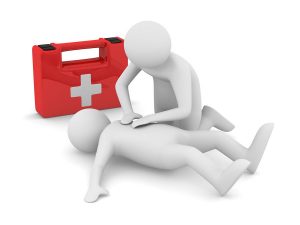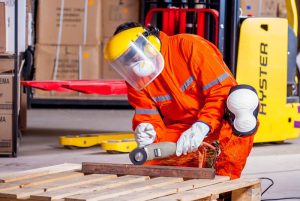 The importance of LEV inspection & testing
The importance of LEV inspection & testing Many jobs across different industries involve work processes that create dust and fumes, which when breathed in can cause diseases, such as asthma, lung scarring and cancer.
Employers are required by law to provide safe working environments and protect employee health, as outlined in the Control of Substances Hazardous to Health (COSHH) Regulations and HSG258 Guide to LEV
Local exhaust ventilation (LEV) systems, also known as extraction or fume control, are used by businesses to control dust and fumes. Over time, the performance of LEV systems can decline, due to wear and tear or blockage. This is why regular inspection and testing – every 14 months to comply with COSHH – is necessary to ensure the systems are operating effectively and hazardous substances are kept controlled.
Safety First carries out LEV inspection and testing in the workplace to help companies ensure that they are fully compliant with COSHH regulations.
Our qualified occupational hygienists are experts in local exhaust ventilation systems. They will monitor and analyse system performance data, as well as perform qualitative evaluations on the control of potential contaminants. Measurements from the test results are compared with the original LEV specification and performance criteria outlined in HSG258.
Safety First will produce reports and records that will assist your business in improving control measures, plus serve as evidence of your company’s compliance with COSHH regulations.
If you require assistance contact us.
 Do you know where your accident book is?
Do you know where your accident book is?
Accident books are a legal requirement.
More specifically, by law, every employer must record accidents to employees and visitors. Two key laws apply to accident reporting/recording at work:
Many people think that the accident book is a health and safety requirement. After all, accidents are a health and safety issue, and regulations that require the reporting of accidents (like RIDDOR) are health and safety regulations too.
So it might surprise you to find out that the law on accident books doesn’t come from a health and safety regulation. The SSCPR makes accident books a legal requirement for businesses employing 10 or more people.
So if you employ less than 10 people, you don’t legally need an accident book under the SSCPR. However, RIDDOR reporting is a legal requirement for businesses of any size, so it makes sense for every workplace to keep an accident book to comply with the law.
If an accident happens, the details of the accident and the injury should be recorded in the accident book.
Schedule 4 of the SSCPR lists the contents that should be entered into an accident book record as:
Accident book records must legally be kept for at least three years. However, it is good practice to keep them for at least 6 years in case of legal action.
The accident book, and any following investigation, can give a complete record of the accident should an insurance claim be made, and should also be seen as an opportunity to improve health and safety and prevent future accidents.
The accident book should be kept by the employer, but there are times when a record may need to be shared with others:
Most of the time, the details recorded in the accident book should be kept confidential and don’t need to be shared or reported to external services like the HSE. Things like minor accidents need to be investigated by the employer but don’t need to be recorded outside the organisation.
Contact us if you require further information.
Early August each year sees Cycle to Work Day, a national and international event encouraging staff to take to two wheels, or three for tricyclists, for 24-hours — and hopefully develop this low-carbon habit on many other work and leisure days.
Contact us if you have any queries.
 Hand Arm Vibration (HAV) can pose a serious health risk, and many firms are not doing enough to help prevent it. Once the damage has been caused, it is permanent, yet it can so easily be prevented. Under the Control of Vibrations at Work Regulations 2005, employers must protect workers from health risks caused by vibration. Failure for your business to have good practice in place can lead to long-term sickness or claims for compensation – potentially damaging your business.
Hand Arm Vibration (HAV) can pose a serious health risk, and many firms are not doing enough to help prevent it. Once the damage has been caused, it is permanent, yet it can so easily be prevented. Under the Control of Vibrations at Work Regulations 2005, employers must protect workers from health risks caused by vibration. Failure for your business to have good practice in place can lead to long-term sickness or claims for compensation – potentially damaging your business.
The Health and Safety Executive has released some good practice advice in order for businesses to understand what they need to do to help prevent Hand Arm Vibration health risks. There are several different factors to consider, and ideally assessment should come from a professional Occupational Hygiene expert such as Safety First Group, in order to identify the risk factors.
HSE has identified some of the following risks and solutions to consider for Hand Arm Vibration:
Selection of work equipment – Employers should demonstrate a sound procurement policy for power tools and hand-guided machines, ensuring that the tool is suitable for the job.
Limiting daily exposure – Maximum times can be determined using the exposure points system or supplier’s “traffic lights” tool categories, but these should be derived from sound “real use” vibration emission values.
Other risk controls – Control of HAV risk by means other than reducing vibration exposure such as aids to support weight or provision of warm clothing and gloves
Information, instruction and training – Employees at risk from vibration should have received information on the risks from HAV and how to help reduce them, and arrangements for health surveillance and their duty to cooperate.
Health Surveillance – Particularly required where the exposure to arm vibration is likely to be exceeded. Employers as a minimum should use a periodic health screening questionnaire – ideally annually and for new employees. Arrangements for referral of relevant cases to an occupational health provider with HAVS expertise for diagnosis and ongoing monitoring should be made.
If your business is unsure of whether you have the sufficient protocols or monitoring in place to protect from the risk of HAV, then contact us. We work with technicians who are highly-qualified and experienced in assessing your workplace for HAV risks and proposing measures for eliminating or minimising these risks.
Contact us for further information.
Employers need to consider the impact extreme summer weather may have on the health of employees. While doing so, the employer must also determine the risk control measures that may be required at such times.

Summer 2022 had seen the UK record its highest ever temperature of 40.3°C, with new national records being set in England, Scotland and Wales.
Although the chances of reaching such high temperatures again in the coming years are said to be extremely low, the Met Office has concluded that the UK will, however, see longer periods with temperatures higher than the seasonal norms.
Although many people may enjoy high summer temperatures, for employers periods of excessive heat can present challenges in terms of meeting their health and safety obligations.
The majority of individuals in the UK will be well acclimatised to the usual summer temperatures. However, with climate change impacts, there is the potential for more periods of hot weather above average summer temperatures.
In these circumstances, individuals are less likely to be able to acclimatise to the higher heat levels leading to “thermal discomfort”.
Thermal discomfort is where people start to feel uncomfortable, ie they are too hot but are not made unwell by the conditions. Most people will not suffer medical symptoms due to the discomfort, beyond irritability and tiredness.
However, extreme heat events can cause significant health issues such as heat exhaustion, heat stroke and other heat stress-related illnesses.
Perhaps less well-recorded, exposure to higher temperatures for longer periods of time can increase the risk of injuries as a result of fatigue, lack of concentration, poor decision making, etc.
Other factors to consider could include increased stress levels, increased pollution levels and even increased exposure to hazardous substances where materials/substances react adversely to extreme temperatures.
It is now well-recognised that other factors will impact any adverse effects of extreme heat. This includes relative humidity, air movement, sun exposure, work demands, clothing and metabolic heat. These factors make up what is known as the “human thermal environment”.
The Health and Safety Executive (HSE) states that “all workers are entitled to an environment where risks to their health and safety are properly controlled. Heat is classed as a hazard and comes with legal obligations like any other hazard”.
Under the Management of Health and Safety at Work Regulations 1999 (MHSWR), employers must assess the risks to workers and put control measures in place to protect those workers.
The HSE states that “temperature in the workplace is one of the risks you should assess whether the work is being done indoors or outdoors”.
Risks must be controlled to as low as reasonably practicable, which means finding a balance between the cost of reducing the risk and the benefits that brings.
A question often asked when undertaking a risk assessment is whether there is a maximum temperature in which workers are required to work. As the HSE states, “there’s no law for maximum working temperature, or when it’s too hot to work, because every workplace is different”.
It continues by noting that no meaningful upper limit can be imposed because in many indoor workplaces high temperatures are not seasonal but created by work activity, eg in bakeries or foundries.
The employer must, therefore, determine what a reasonably comfortable temperature should be at the workplace based upon the findings of a risk assessment. There can be many inputs into the risk assessment, including:
The HSE has also produced a useful “heat stress checklist” that may help inform an employer’s decision regarding risk control measures.
There is nothing stating what is meant by “comfortable” as what one person deems reasonably comfortable may not be the same as what is deemed reasonably comfortable by another, and this is where difficulties often lie for employers and employees alike.
It is probably the case that during much of the year, workplace temperatures are within a zone that is deemed to be comfortable for the majority of workers and it is only during exceptional periods of heat that workers begin to suffer from thermal discomfort and/or the health effects of heat exposure.
As such, employers may determine that it is necessary to have additional risk control measures adopted to take account of exceptional seasonally hot weather.
This can be based upon the needs of an individual (taking into account the employer has a duty of care to individual employees) or collectively for a group of workers.
In taking this approach, the employer will require a form of “trigger point” that informs them when additional risk control measures may be required due to hot weather.
One tool that may be used is the UK Health Security Agency’s Heat-Health Alert system. Although primarily aimed at the organisations required to undertake public health action, the system does provide useful information.
From summer 2023, Heat-Health Alerts transitioned to an impact-based alerting, which provides users with information over and above the fact that hot weather is likely to occur. It gives an indication of the impacts likely to be observed as a result of the temperatures. The alerts are given a colour, as shown below.
In conjunction with the above, the Met Office has the National Severe Weather Warning Service, which is a warning service based on the impact of the UK weather rather than a threshold of the weather itself. Warnings are graded as yellow, amber and red, and, among other matters, give the following information:
Utilising the above information, employers may determine that pre-planned additional risk control measures are necessary to ensure that their employee’s health is not adversely impacted by extreme summer weather.
Summer extreme weather can be said to be foreseeable and as such employers need to consider the impacts this may have on the health of employees.
In doing so, a suitable and sufficient risk should be undertaken to take into consideration the impacts of such weather conditions. In doing so, the employer may determine that additional risk control measures may be required at times of extreme hot weather.
In such cases, suitable planning must be put in place to ensure the risk control measures deemed necessary are implemented. This could be through the use of trigger points such as UK weather warning systems.
In general terms, this could include:
Contact us for further advice.
Check out our blog by clicking here!